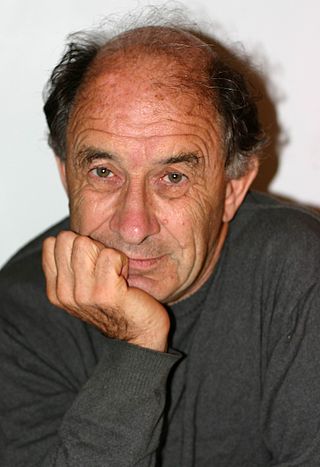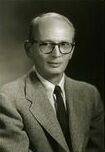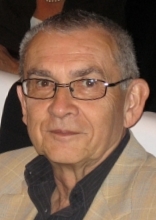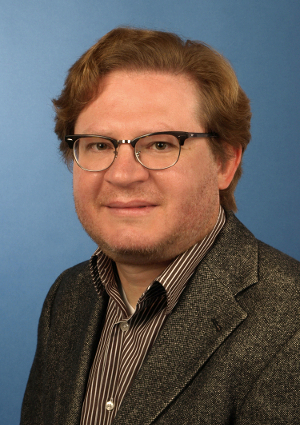
Sergei Tabachnikov, also spelled Serge, (in born in 1956) is an American mathematician who works in geometry and dynamical systems. He is currently a Professor of Mathematics at Pennsylvania State University.

Sergei Tabachnikov, also spelled Serge, (in born in 1956) is an American mathematician who works in geometry and dynamical systems. He is currently a Professor of Mathematics at Pennsylvania State University.
He earned his Ph.D. from Moscow State University in 1987 under the supervision of Dmitry Fuchs and Anatoly Fomenko. [1] He has been living and working in the USA since 1990.
From 2013 to 2015 Tabachnikov served as Deputy Director of the Institute for Computational and Experimental Research in Mathematics (ICERM) in Providence, Rhode Island. [2] He is now Emeritus Deputy Director of ICERM. [3]
He is a fellow of the American Mathematical Society. [4] He currently serves as Editor in Chief of the journal Experimental Mathematics. [5]
A paper on the variability hypothesis by Theodore Hill and Tabachnikov was accepted and retracted by The Mathematical Intelligencer and later The New York Journal of Mathematics (NYJM). There was some controversy over the mathematical model, the peer-review process, and the lack of an official retraction notice from the NYJM. [6]

Vladimir Igorevich Arnold was a Soviet and Russian mathematician. While he is known for the Kolmogorov–Arnold–Moser theorem regarding the stability of integrable systems, he made contributions in several areas including geometrical theory of dynamical systems theory, algebra, catastrophe theory, topology, algebraic geometry, symplectic geometry, symplectic topology, differential equations, classical mechanics, differential geometric approach to hydrodynamics, geometric analysis and singularity theory, including posing the ADE classification problem, since his first main result—the solution of Hilbert's thirteenth problem in 1957 at the age of 19. He co-founded two new branches of mathematics—KAM theory, and topological Galois theory.

The Alexander horned sphere is a pathological object in topology discovered by J. W. Alexander (1924).

Salomon Bochner was an Austrian mathematician, known for work in mathematical analysis, probability theory and differential geometry.
Richard Evan Schwartz is an American mathematician notable for his contributions to geometric group theory and to an area of mathematics known as billiards. Geometric group theory is a relatively new area of mathematics beginning around the late 1980s which explores finitely generated groups, and seeks connections between their algebraic properties and the geometric spaces on which these groups act. He has worked on what mathematicians refer to as billiards, which are dynamical systems based on a convex shape in a plane. He has explored geometric iterations involving polygons, and he has been credited for developing the mathematical concept known as the pentagram map. In addition, he is a bestselling author of a mathematics picture book for young children. His published work usually appears under the name Richard Evan Schwartz. In 2018 he is a professor of mathematics at Brown University.

Yuri Ivanovich Manin was a Russian mathematician, known for work in algebraic geometry and diophantine geometry, and many expository works ranging from mathematical logic to theoretical physics.

Phillip Augustus Griffiths IV is an American mathematician, known for his work in the field of geometry, and in particular for the complex manifold approach to algebraic geometry. He is a major developer in particular of the theory of variation of Hodge structure in Hodge theory and moduli theory, which forms part of transcendental algebraic geometry and which also touches upon major and distant areas of differential geometry. He also worked on partial differential equations, coauthored with Shiing-Shen Chern, Robert Bryant and Robert Gardner on Exterior Differential Systems.

Victor Matveevich Buchstaber is a Soviet and Russian mathematician known for his work on algebraic topology, homotopy theory, and mathematical physics.
John Willard Morgan is an American mathematician known for his contributions to topology and geometry. He is a Professor Emeritus at Columbia University and a member of the Simons Center for Geometry and Physics at Stony Brook University.
John Michael Boardman was a mathematician whose speciality was algebraic and differential topology. He was affiliated with the University of Cambridge, England and the Johns Hopkins University in Baltimore, Maryland. Boardman was most widely known for his construction of the first rigorously correct model of the homotopy category of spectra.

In geometry, a flexible polyhedron is a polyhedral surface without any boundary edges, whose shape can be continuously changed while keeping the shapes of all of its faces unchanged. The Cauchy rigidity theorem shows that in dimension 3 such a polyhedron cannot be convex.
Ellis Robert Kolchin was an American mathematician at Columbia University. Kolchin earned a doctorate in mathematics from Columbia University in 1941 under supervision of Joseph Ritt. He was awarded a Guggenheim Fellowship in 1954 and 1961.
Mikhail Mikhailovich Postnikov was a Soviet mathematician, known for his work in algebraic and differential topology.
Frank Morgan is an American mathematician and the Webster Atwell '21 Professor of Mathematics, Emeritus, at Williams College. He is known for contributions to geometric measure theory, minimal surfaces, and differential geometry, including the resolution of the double bubble conjecture. He was vice-president of the American Mathematical Society and the Mathematical Association of America.

Yakov Matveevich Eliashberg is an American mathematician who was born in Leningrad, USSR.

Matthias Kreck is a German mathematician who works in the areas of Algebraic Topology and Differential topology. From 1994 to 2002 he was director of the Oberwolfach Research Institute for Mathematics and from October 2006 to September 2011 he was the director of the Hausdorff Center for Mathematics at the University of Bonn, where he is currently a professor.

In geometry, Steffen's polyhedron is a flexible polyhedron discovered by and named after Klaus Steffen. It is based on the Bricard octahedron, but unlike the Bricard octahedron its surface does not cross itself. With nine vertices, 21 edges, and 14 triangular faces, it is the simplest possible non-crossing flexible polyhedron. Its faces can be decomposed into three subsets: two six-triangle-patches from a Bricard octahedron, and two more triangles that link these patches together.

Dmitry Feichtner-Kozlov is a Russian-German mathematician.

Dmitry Borisovich Fuchs is a Russian-American mathematician, specializing in the representation theory of infinite-dimensional Lie groups and in topology.

In geometry, the tennis ball theorem states that any smooth curve on the surface of a sphere that divides the sphere into two equal-area subsets without touching or crossing itself must have at least four inflection points, points at which the curve does not consistently bend to only one side of its tangent line. The tennis ball theorem was first published under this name by Vladimir Arnold in 1994, and is often attributed to Arnold, but a closely related result appears earlier in a 1968 paper by Beniamino Segre, and the tennis ball theorem itself is a special case of a theorem in a 1977 paper by Joel L. Weiner. The name of the theorem comes from the standard shape of a tennis ball, whose seam forms a curve that meets the conditions of the theorem; the same kind of curve is also used for the seams on baseballs.
Yongbin Ruan is a Chinese mathematician, specializing in algebraic geometry, differential geometry, and symplectic geometry with applications to string theory.